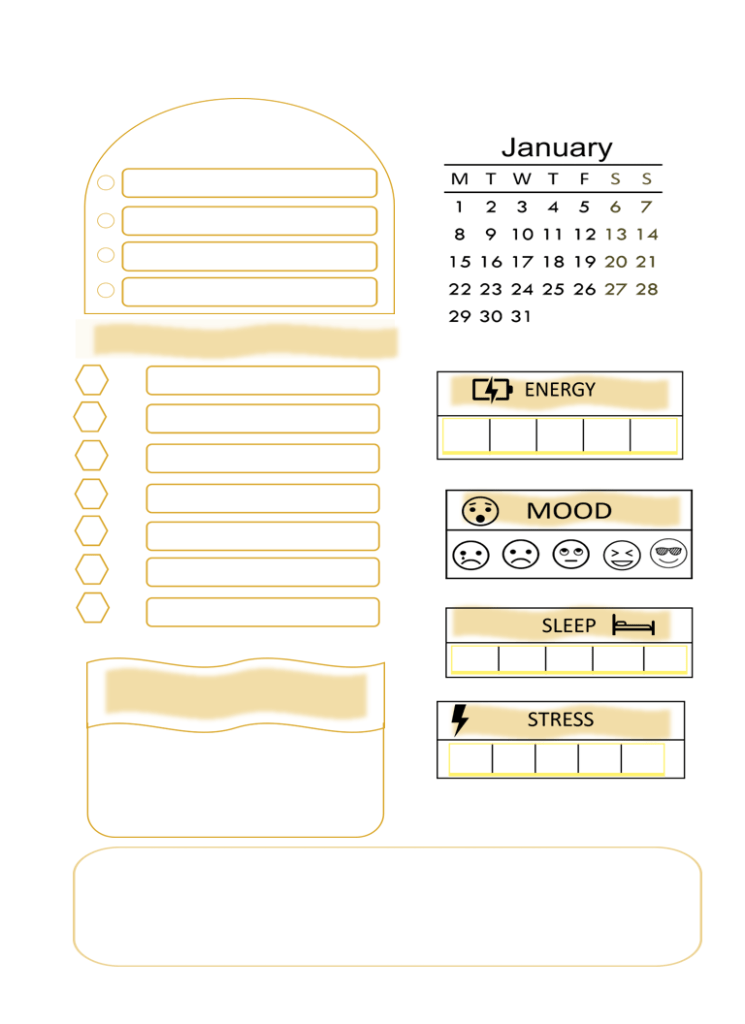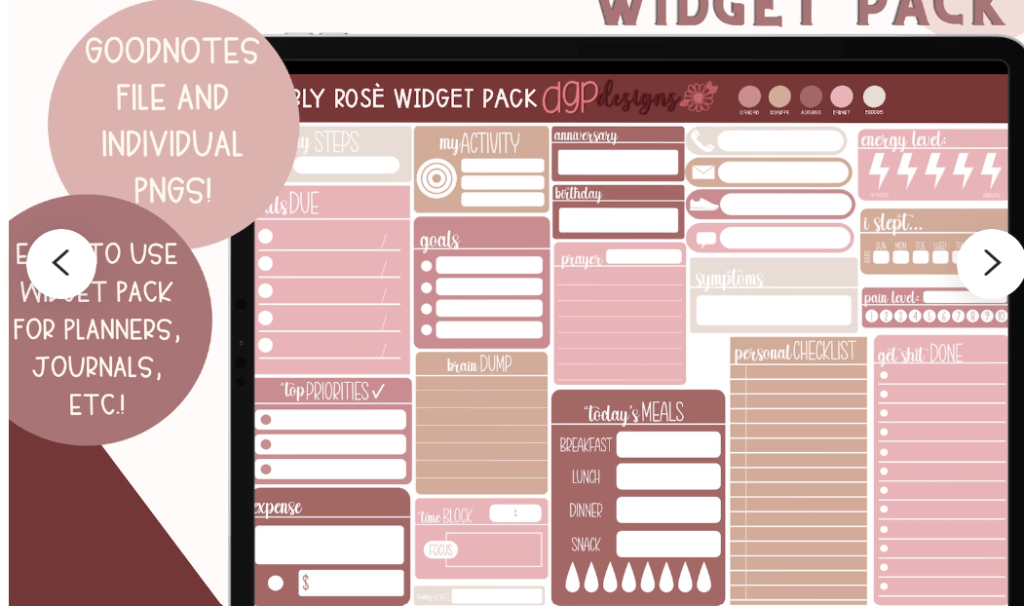The term widgets has been used to describe many things. It originally described an app on your device such as a clock or even a step counter. Now content creators talk about widgets that are really pieces of content that you can use to speed up the creation of planners. They are module images that can be assembled into unique page layouts.

Planners Are Popular But Need to Be Flexible
Planners have always been popular for people seeking to stay organized, manage their time effectively, and achieve their goals. The demand for planners continues to grow as people recognize the value of having a tangible system to track tasks, appointments, and milestones.
And not only are they indispensable to users, content creators have found new ways to customize planners that also speeds creation. One of the key factors that contribute to the success of a planner is its ability to cater to individual needs and preferences. Everyone has their own unique way of organizing their lives, and a one-size-fits-all approach simply doesn’t cut it anymore.
This is where the concept of customizable planners comes into play. By allowing users to tailor their planners according to their specific requirements, customizable planners empower individuals to create a system that aligns perfectly with their personal style and enhances their productivity.
What are Widgets
Enter widgets – versatile elements that have revolutionized the way we design and use planners. In the context of planners, widgets are small, modular components that can be easily inserted, rearranged, and customized to fit different planning layouts. These widgets encompass a wide range of functionalities, from calendars and to-do lists to habit trackers and meal planners.
The beauty of using widgets to create both printable and digital planners lies in the flexibility they offer. With printable planners, you can handpick and arrange the widgets in a way that best suits your needs, and have the satisfaction of holding a tangible planner in your hands. On the other hand, digital planners leverage the power of technology, allowing you to effortlessly add, remove, or modify widgets as your planning requirements evolve. The use of widgets have changed the way planners are created.
Overview of Different Types of Widgets Commonly Used in Planners
Widgets come in various forms, each serving a unique purpose to enhance the planner. Here are some popular types of widgets commonly used in planners:
Calendars: Calendar widgets allow you to view and manage dates, appointments, and events easily. You can navigate through months, weeks, or days, and some may even provide options for color-coding or adding reminders.
To-Do Lists: To-do list widgets help you stay on top of your tasks and track their completion. They allow you to create, organize, and prioritize your to-do items, ensuring that nothing falls through the cracks.
Habit Trackers: Habit tracker widgets enable you to monitor and cultivate positive habits. You can create custom trackers for habits such as exercise, reading, water intake, or meditation, and visually track your progress over time.

Goal Trackers: Goal tracker widgets help you set and track progress towards your long-term goals. They provide a visual representation of your milestones, motivating you to stay focused and accountable.
Meal Planners: Meal planner widgets assist in planning and organizing your meals. You can create weekly menus, track grocery lists, and even add recipes or nutritional information to make meal planning a breeze.
Benefits of Using Widgets for Planner Customization and Organization
The use of widgets in planner customization offers several benefits:
Flexibility: Widgets provide the flexibility to arrange and modify your planner’s layout based on your evolving needs. You can easily add, remove, or rearrange widgets as your planning requirements change.
Personalization: Widgets allow you to infuse your planner with your unique style and preferences. You can customize colors, fonts, and designs to create a planner that reflects your personality.
Enhanced Organization: By utilizing widgets, you can streamline and compartmentalize different aspects of your planning. Widgets act as dedicated spaces for specific tasks or information, making it easier to navigate and locate essential details.
Efficient Planning: Widgets bring efficiency to your planning process by providing specialized tools. Whether it’s tracking habits, managing tasks, or scheduling appointments, widgets streamline these functions, saving you time and effort.
Color Palettes: Keep in mind that if you are making a printable planner, it needs to be ink friendly. This doesn’t mean NO color, it means light colors in selected places so it prints out nicely. But if you are using a Digital Planner, all your widgets can use a custom color palette. In fact color will be a benefit.
Understanding the concept of widgets and their role in planner customization empowers you to create a planner that perfectly aligns with your organizational needs and aesthetic preferences. By incorporating different types of widgets into your planner, you can create a comprehensive and personalized planning system that enhances productivity and helps you stay on top of your goals.
How Do You Make Widgets
Graphic Design Software: Use graphic design software like PowerPoint, Affinity, Adobe Photoshop, Illustrator, or Canva to design your widgets. Create a page and start creating different sizes. Remember, you will save as a PNG image and can easily resize.
Then, add elements such as text boxes, shapes, icons, and images to construct the widget. I keep a file of my original units, before saving as a PNG in case I want to recolor, add other elements and redesign. Then simply save the new design as an image.
Use shapes to define space for notes and tables to create lists of all types. You can use outlines to define spaces, or leave it without an outline.
Export or Save: Once your image is ready, save it in as a PNG. Ensure the resolution is high enough for printing to maintain clarity. I like to have a transparent background so it can be layered on top of images or backgrounds.
Customization: I customize the elements by applying colors and texts when I am ready to use them. You can add shapes for color beneath the table or shape, add text to the individual headings or lines. By keeping the different pieces “neutral”, they can be used interchangeably.
I do notice on ETSY that sellers are creating and selling widgets in a variety of styles and colors for use in digital planners. If using in a digital planner, it is easier to include vibrant colors and not have to worry about ink. Check out these for ideas: Daily Planners and DGP Designs.

This is one of the packs that is available on ETSY with 100 different images in PNG format created for digital planners or notebooks. Customer can use these individual images to create the perfect layout that they can use. So if you get inspired by creating these elements (which are really stickers) you can sell packs of these.
Need more ideas for working with planners, journals and workbooks? Check out Ideas for Workbooks, and Gratitude Printables.